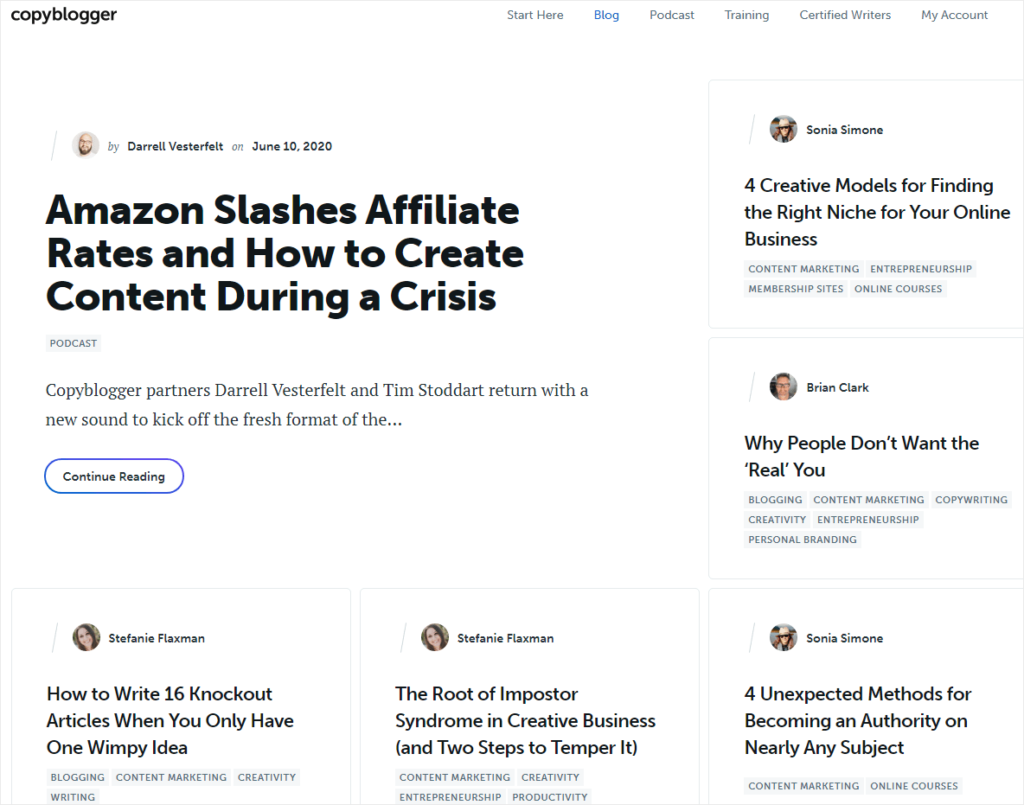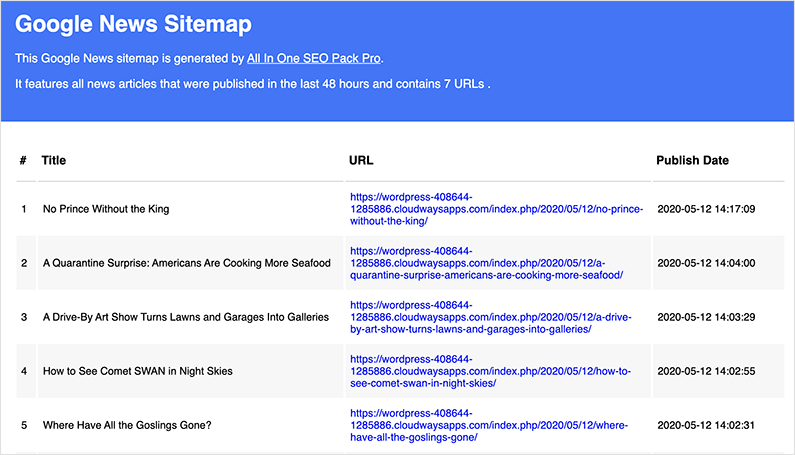Did you know that blogs and other non-newspaper websites can get listed on Google News? Smart bloggers and website owners have been using it to get targeted traffic to their blogs, and so can you.
Google News links to sites and blogs that publish timely, topical articles on a variety of topics. You don’t have to be a news site to get listed on it, but you need to publish newsworthy content regularly.
If your blog or site publishes industry-leading articles, and you’re at the forefront of information that’d be of interest to people on a timely basis, Google considers you a news publisher. Which means you can get your blog listed on Google News.
To get your share of the billions of clicks these articles get, you’ll need to know how to submit your blog to Google News. You’ll also need to know how to get your posts indexed by their sitemap crawler and ranked in Google News.
That’s why we’ve gathered the top 10 tips to optimize your blog and create the high-quality content Google News publishes.
Ready? Here we go.
Submitting Your Blog to Google News
According to Google’s website, there are two steps to submitting content to Google News.
- Sign up to Publisher Center and add your blog as a publication.
- Publish high-quality content that complies with Google News content policies.
As a publication in Google News, you can import your content, manage access, and optimize how your content is displayed and delivered to users. For all the details on how to submit your blog as a publisher to Google News, read this post. When you first submit your blog to Google News, it’ll take 2-4 weeks to review your content and make it available for consumption by readers.
To ensure your blog is accepted and your posts appear as news items in Google News, you’ll want to make sure you publish high-quality content that meets or exceeds Google’s content policies. We’ve gathered the top 10 tips you can use to optimize your blog and content so they can’t resist it.
Preparing Your Blog For Google News
Follow these steps to create high-quality content that’s picked up by Google News every time you publish it.
1. Know and Follow Google’s Guidelines
Just like their regular search engine, Google News uses an algorithm to crawl for news content. To help it determine which pages of your blog are articles and avoid your blog being rejected because you didn’t follow the rules, make sure it meets the Google News content policies.
For example, your blog content must:
- Be original content
- Provide precise dates, bylines, author bios, information about your site, and contact information
- Always disclose ads and sponsored content
- Not infringe on anyone’s copyrights or intellectual property
- Not contain sensitive or hateful content
- Avoid link schemes, malware, viruses, or other harmful software that generate unnatural traffic, content, or any other behavior
Make sure your blog content is valuable and presented sincerely and objectively to avoid running afoul of Google News’ content policies.
2. Develop a Niche or Specific Topic for Your Content
Another thing Google News looks for is sources with unique points of view. There are so many sites that already report on and write about general topics or news. Niche sites and blogs that provide in-depth information on specific areas are more likely to be indexed and placed in the Top Stories section of Google News.
For example, a blog on general fitness won’t make the cut, but one on “fitness for people who spend a lot of time on the computer” will. A generic recipe blog will be skipped, but a “food blog for parents of picky eaters” makes the cut. Try to zero in on a narrow niche for your blog to increase the odds Google News will pick up your articles.
3. Write Keyword-Rich Headlines That Communicate a Story
To increase your chances of having your blog posts picked up by Google News, write straightforward blog titles and headlines. Stories that use familiar words, convey a sense of what readers will learn, and steer clear of linkbait headlines get picked up more regularly.
Copyblogger does this exceptionally well with their articles.

Here are a few tips for writing newsworthy headlines for your blog posts:
- Include your keywords.
- Don’t repeat words in the headline – If you’ve optimized the post for SEO, there’s no need to repeat your keywords multiple times in the headline.
- Use active voice – When writing in the active voice (“John bought a laptop”), you can say more with fewer words and capture your readers’ attention. The passive voice is always longer (“The laptop was purchased by John”) and doesn’t explain what’s going on.
- Write in the present tense – News is all about what’s going on right now, not what happened 5 minutes ago or last year. Even if your post talks about something in the past, you have to relate it to the present and why it’s relevant to readers.
- Capitalize the right words – Google News shows headlines that use two types of capitalization rules: title case and first word plus proper noun capitalization. It doesn’t matter which you use, just be consistent. For instance, here, you’ll see several examples of both types of capitalization on Google News. “The Actor Who Played a Major ‘Scooby-Doo’ Character Since 1969” uses title case, while “The 10 best weird superhero movies that aren’t Marvel or DC” only capitalizes the first word and all proper nouns.

4. Write News-related Posts, Not Evergreen Content
As a blogger, you usually want to write evergreen content that people can come back to. When trying to get indexed by Google News, however, you want to write news-worthy posts instead. These posts should be timely and related to something going on right now. Otherwise, Google won’t index it.
5. Optimize Every Post
Because Google News lets readers customize their feeds so they only see content from their preferred categories or search terms, you want to make sure your blog and your published articles are optimized.
A few tips to remember are:
- Write scannable headlines and subheadings.
- Include relevant keywords and phrases in your subheadings.
- Create readable URLs for your posts. E.g. remove instances of “the” and “and” from the URL.
- Have static, unique URLs for each post.
- Avoid ampersands and other symbols in the URLs.
6. Create a Sitemap
A sitemap is an XML page that outlines your site’s structure and lists all the important pages and elements on it. Search engines use it to crawl your site and understand your site structure.
For Google News, you’ll want a news-specific XML sitemap, which lists the posts you’ve published within the last 48 hours, up to a maximum of 1,000 articles. Google will look at both sitemaps when it crawls your website, but it mainly uses the news sitemap when it considers adding content to Google News. Create your sitemap following Google’s step-by-step instructions or use a WordPress plugin like All in One SEO.

All in One’s news sitemap feature creates your news sitemap automatically and submits it to Google News for you. You can choose which post types to include in your Google News Sitemap, including any custom post types you may have.
7. Use Clean Code
It’s always good to have clean code, so your blog displays properly, but it also helps with the Google News site crawler. Google News can index your blog more efficiently and quickly if you avoid putting extra code in your blog posts, such as ad blocks, related articles, or video carousels. Avoid frames or other non-readable formats in your posts. Straightforward content and code work better for Google News.
8. Use Proper Content Formatting
If your posts have a lot of images, videos, and infographics, the site crawler will have a hard time indexing your content. Site crawlers can only see code and text, and can’t comprehend the content you’ve published. Make sure to format your content in ways that crawlers can understand, with the proper tags on all subheadings and images, adding NOFOLLOW links to those you don’t want indexed, and alt tags and descriptions on all images.
If you must include multimedia in your blog posts, be sure it has title and header tags that describe what the content is about. Then, write a description of the image, video, or whatever media it is. That’s just good blog writing, but it also helps Google index the post more easily and gets you the benefit of the media content.
9. Publish Posts Daily
Not only do your posts need to be timely, but you’ve also got to write them consistently. Just writing a timely post once in a while won’t cut it with Google News. Remember the news sitemap mentioned earlier? It lists the last 1,000 posts you’ve published on your blog. It contains a date stamp for each new post, so if the site crawler doesn’t see recent dates in that sitemap, it’ll stop crawling your site as often and won’t include your posts in Google News.
Aim to publish at least once daily, but ideally twice a day, every day. The Google site crawler will come back to your blog more often once it sees that you publish daily, giving your content a better chance at being chosen for Google News.
10. Have Multiple Authors
Most blogs start with one person writing all the posts, but as you grow, you may add guest bloggers and other writers to the site. From a Google News perspective, multiple authors elevate your blog above all others. It’s a subtle signal that your site will be updated regularly, contain unique content, and be a news source, even if you’re not a traditional online magazine or website.
Smart bloggers and website owners have started tapping into Google News for its targeted traffic and better search engine visibility. But to reap the full benefits of Google News for your blog, you’ve got to do a bit of homework.
You’ll need to write high-quality content, publish it regularly, optimize your content, and add a news sitemap to your site. Use these 10 tips as a checklist to prepare your blog for Google News. If you get through all 10, you’ll enjoy a nice bump in traffic to your blog and bring your content to a broader audience.

